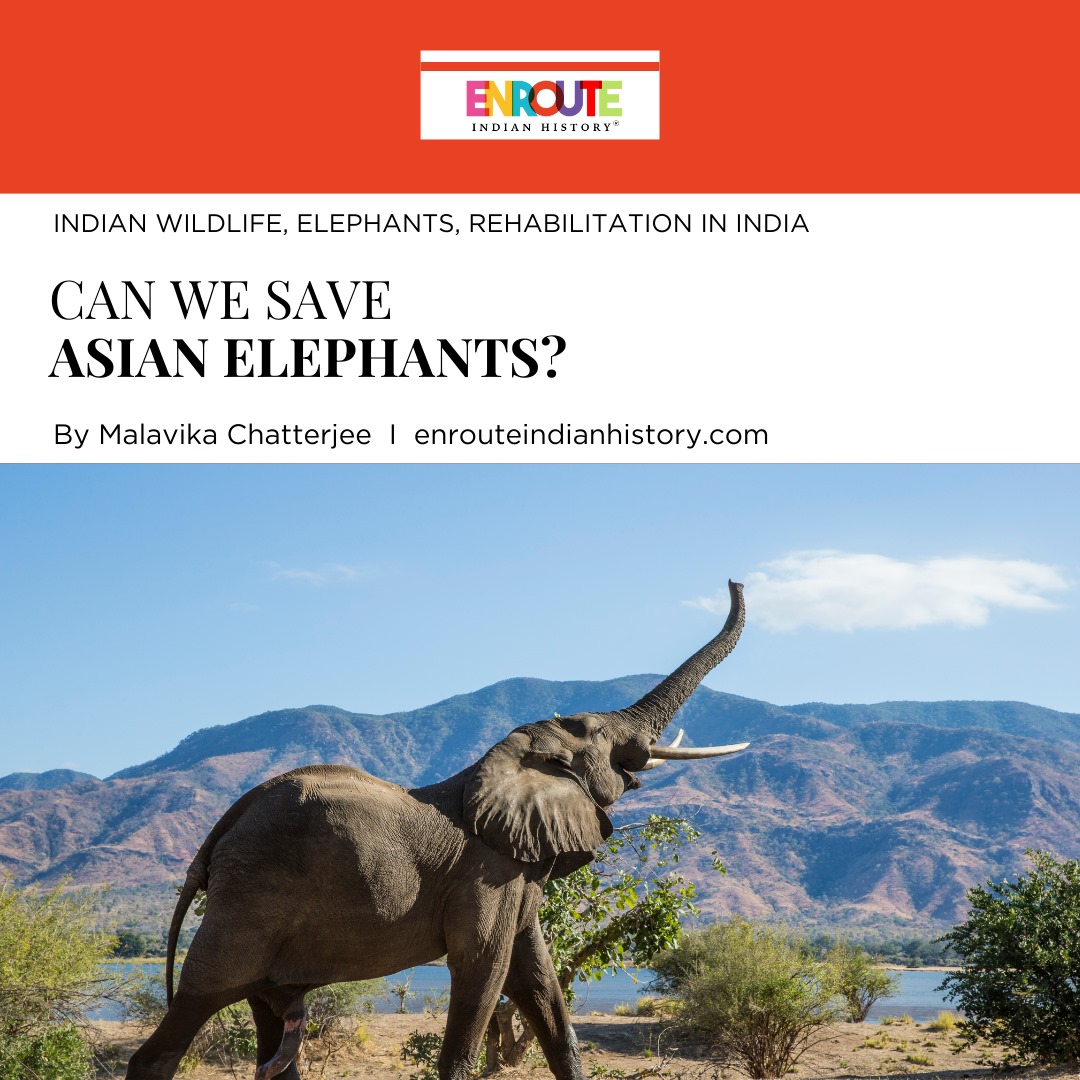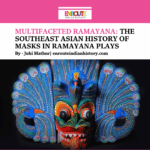
Elephants have been roaming this planet for more than 9 million years (specifically the Elephantidae family) and shaping the earth as a keystone species (Paine 1966; see further Menge et al. 2013). These gentle giants have fascinated humanity due to their enormous size, intelligence, and impact on local ecosystems. These behemoths are known for their immense strength and are revered in different cultures and religions like Buddhism and Hinduism. Sadly, however, the dark side of human-elephant interaction is the wide-scale habitat loss, poaching, and fatalities on both sides.

Source: https://wildlifesos.org/locations/ch-surinder-singh-elephant-rehabilitation-centre/
Elephants roaming freely at the Rehabilitation Centre
Endangered and Dwindling Population.
The Asian elephants once roamed freely in an area extending from the Tigris and Euphrates Rivers in West Asia, across South and Southeast Asia, to the Yangtze River in China (Olivier 1978). According to Shoshani and Eisenberg (1982), there are three subspecies of the Asian Elephant which are Elephas maximus indicus (India), Elephas maximus maximus (Sri Lanka), and Elephas maximus sumatranus (Sumatra). Although elephants do not have any natural predators, Madhavan (2018) rightly notes that humans have assumed that role since prehistoric times. Today, elephants have disappeared from more than 95% of this historical range, equal to more than 9 million sq. km (Sukumar 2003, as mentioned in Choudhury et al. 2008). According to Sukumar (2006), today, we find a fragmented Asian elephant population in 13 ranges countries (Choudhury et al. 2008), 60% of which is in India.
According to the IUCN Red List, Asian elephants have been an endangered species since 1986 due to anthropogenic factors leading to habitat loss with more than 50% of their population decimated. The World Wildlife Fund states that barely 52,000 Asian elephants remain in the wild. Project Elephant by the MoEFCC (Ministry of Environment, Forest and Climate Change) states that about 60% of the global elephant population, approximately 29 thousand elephants, reside in India (according to the 2017 census). According to the WWF, human-elephant conflict (HEC), fragmented habit and habitat loss, illegal wildlife trading, poaching, and climate change have severely declined elephant populations.
Tracing the History of Elephants
The oldest known fossil of the Asian or Asiatic Elephant (Elephas maximus) dates to more than 2 million years (Nanda et al. 2017). However, the first, albeit indirect, evidence of human-elephant interaction in India comes from prehistoric rock art from various parts of the country. Later, elephants were depicted on seals and in the form of figurines during the Harappan Civilisation. Whether they were domesticated or not is still a matter of debate. However, archaeologists have found ivory objects at sites from this period (Rao 1979; see further Miller 2020). Throughout recorded history, elephants have been considered a symbol of strength and fertility, especially in Buddhist and Hindu religious texts and mythologies. Elephants have been mentioned in various vernacular as well as religious literature, including the epics Ramayana and Mahabharata, Pancatantra stories as well as the Jataka tales, Aithihyamaala by Kottarathil Sankunny, Kautiliya’s Arthasahtra, the Gajashastra and Hasthi Ayurveda by Palakapya Muni and the Matangaleela by Neelakantha, to name a few. Amongst these, the Gajashastra of the 5th-6th century BCE is the most important and is essentially an ancient elephant guidebook.

Source: https://www.asesg.org/
Past and Present distribution of the Asian Elephants (Elephas maximus)
Indra’s mount or vahana is a white elephant, Airavatha, the King of Elephants. The birth of Siddhartha is also associated with a white elephant who came into Queen Maya’s dream. The elephant is symbolic of Indian culture, evidenced by celebrating Ganesh Chaturthi, a festival dedicated to Ganesha, the elephant-headed God. The famous Mysore Dasara procession of ornately dressed and colourfully decorated elephants also shows the value of elephants in Indian culture.

Source: https://wildlifesos.org/our-work/elephants/
State-wise distribution of wild elephants in India
Importance of Elephants
Elephants are vital to our ecosystem as they are our ecosystem engineers (Jones et al. 1966). According to Menge et al. 2013, keystone species like elephants influence “the structure and dynamics of ecosystems and communities”. They shape, maintain, and, to a certain extent, revive their environments, helping the animal community around them. For instance, they make pathways in forests or habitats with dense vegetation that also helps with dispersing seeds and “creating clearings and gaps in the canopy that encourage tree regeneration” https://www.worldwildlife.org/. In areas where surface water is scanty, elephants dig for water and provide water access for all.

Source: © Sumanth Kuduvalli / Felis Creations / WWF
https://www.wwf.org.uk/learn/wildlife/asian-elephants
Historically, the exploitation of elephants brought to light their immense value to humans. Their size and strength helped people traverse dense forests and clear forested areas while lifting or dragging heavy loads of timber. Later, they provided value in times of war, and the Indian elephant cavalry became famous. The story of Bhima killing Ashwathama, the elephant, as a ploy to kill Dronacharya is well known. In the battle of Kurukshetra, King Bhagadatta of Kamrupa provided 10,000 elephants to the Kauravas (Easa 2019). Gradually, the use of elephants in war became popular, especially during the Mauryan times.
We are the Predators
One of the major causes for the IUCN Red List status of Asian elephants is the loss of habitat. With our ever-growing population, there has been a drastic reduction in forest cover, leading to the loss of the wild elephant population (Sukumar 2006). In India specifically, expansive agricultural activities and infrastructural projects like the construction of dams have severely affected the elephant population and migration (Sukumar 2006).
The Gajashastra likely provides the first recorded evidence of the human-elephant conflict (HEC), stating the destruction of the Kingdom of Anga (present-day Bihar and West Bengal) by elephants. The reason for higher human deaths by Asian elephants compared to African elephants is that Asian elephants currently inhabit areas with high human population density. Inadvertently, this results in the loss of crops and the destruction of property. According to the study by Naha et al. 2020, elephant raids frequently occurred in villages producing haaria-rice beer (in the northeast region of India). The other reason is “the seasonal harvesting pattern of major agricultural crops” (Naha et al. 2020).
More often than not, news of animal cruelty and exploitation becomes public knowledge through social media. The horrific acts and sadistic treatment of elephants for the sake of human entertainment are appalling, and elephant tourism is one of the leading causes of the exploitation and abuse of elephants. According to a CNN report (2023), riding elephants leads to severe deformities and ailments in elephants. A PETA article on elephant cruelty also highlights the psychological trauma they undergo for the amusement of humans. The onus of their miserable condition and endangered statues lies with us. So does their rehabilitation. World Animal Protection states that other seemingly harmless activities like bathing elephants or taking selfies disguise the inhumane torture that elephants endure, only to be tamed and respond to fear.
Elephant corridors are significant for the maintenance of elephant populations. However, Easa (2019) states that HEC and various anthropogenic factors have interrupted usual migratory routes and walking patterns, resulting in the division of herds. He adds that although corridors are essential for habitat connectivity, numerous corridors have also resulted in fragmentation of habitats. Another factor compounding the dwindling population of elephants is that female elephants have a long gestation period of almost two years (20-21 months) and can produce a calf after a period of four to five years (see Sukumar 2006). Moreover, these megafaunas have a great appetite, which they satiate by eating approximately 150 kg of food consumed over 12-18 hours a day (see Shoshani and Eisenberg 1982; Sukumar 2006).
Between the late 1970s and 1980s, the export of ivory and its trade was banned in India. However, poaching threatens the long-term survival of elephants. Although some Asian elephants lack tusks, poaching sadly extends to elephant leather and sometimes meat (see Choudhury et al. 2008).
Welfare Schemes and Centres
According to Kautilya’s Arthshastra, the punishment for killing an elephant was death (see Tisdell 2005). Various legislations have been implemented for the welfare of elephants in India since the late 1800s (Easa, 2019), with the Wildlife (Protection) Act of 1972 being the most significant in protecting elephants. The Government of India launched Project Elephant in 1992 for the protection of elephants and their habitats, the welfare of elephants in captivity as well as address the rising HEC. Project Elephant provides funding and technical support to those engaged in elephant conservation and management through state-run programs. An international network of specialists called the Asian Elephant Specialist Group (AsESG) studies, monitors, manages and aids the conservation of Asian elephants across Asia.
Easa (2019) suggests that for the better health of the elephants, there should be fewer larger corridors, covering a wider landscape for the herds. He gives the example of Wayanad and its adjacent areas where only a few corridors exist, indicative of the “better status of the habitat in the region” (Easa 2019). Unfortunately, corridors are not an effective marker for gauging the degradation of elephant habitat or the challenges imposed for its conservation. Naha et al. (2020) point out that in such shared landscapes, loss of habitat and HEC, along with poaching, severely affect the conservation efforts of elephants. P.S. Easa (2019) suggests that larger areas should be identified and secured as elephant corridors in regions with high HEC. For instance, “the Wayanad–Bandipura–Nagarahole–Mudumalai” landscape provides a landscape of almost 12,700 sq. km. with over 6,000 elephants”, making it “the largest habitat of Asian elephants” (Easa, 2019).

Source: https://wildlifesos.org/locations/ch-surinder-singh-elephant-rehabilitation-centre/
Elephants at the Rehabilitation Centre
In 2010, the Elephant Conservation and Care Centre (ECCC) was established in Mathura, Uttar Pradesh with the Uttar Pradesh Forest Department. Other centres like The Ch. Surinder Singh Elephant Rehabilitation Centre (ERC) in Yamunanagar, Haryana; the Wildlife SOS Elephant Hospital, Uttar Pradesh; the Kottur Elephant Sanctuary and Rehabilitation Centre, Thiruvananthapuram, Kerala to name just a few, are a step forward towards elephant rehabilitation in India. The Dubare Elephant Camp is a project initiated by the forest department and Jungle Lodges and Resorts Ltd. Madhavan (2018) states that the camp houses ‘man-killers’ or elephants who have killed humans. They are captured and domesticated by the Jenu Kurubas, an ethnic community with expertise in handling and taming elephants.
The Buffer Conflict Resolution Trust of India (BCRTI) is an NGO that helps establish communication between local inhabitants and forest officials and raise awareness of the wildlife in buffer zones. The WWF has a Forest certification System that inspects and tracks “timber, paper pulp and other forest products to make sure they’ve been harvested according to a strict set of guidelines” through the Forest Stewardship Council (FSC).
You Can Help!
Social media is a double-edged sword. While there is no denying its value in shedding light on the inhumane practices and methods to tame elephants, it has also contributed to the growth of elephant tourism (see further Role Of Social Media In Conservation – Wildlife SOS). Where there is demand, supply follows. One can consciously stop contributing towards elephant tourism at places where there are activities involving elephants for entertainment. If you would like to help the cause, the World Wildlife Fund has the Adopt An Animal Now Initiative, where you could contribute any amount of money and adopt an animal on their list. Raising awareness is key, especially for the new generation. Protecting the Asian elephant, and all elephants in general, will positively impact their health, habitat, and our environment.
References:
Annual Report 2022-2023: Ministry of Environment Forest and Climate Change
Choudhury, A., Lahiri Choudhury, D.K., Desai, A., Duckworth, J.W., Easa, P.S., Johnsingh, A.J.T., Fernando, P., Hedges, S., Gunawardena, M., Kurt, F., Karanth, U., Lister, A., Menon, V., Riddle, H., Rübel, A. & Wikramanayake, E. (IUCN SSC Asian Elephant Specialist Group). 2008. Elephas maximus. The IUCN Red List of Threatened Species 2008: e.T7140A12828813. http://dx.doi.org/10.2305/IUCN.UK.2008.RLTS.T7140A12828813.en
Easa, P. 2019. Asian Elephants in History and Culture: An Overview. Sahapedia Asian Elephants in History and Culture: An Overview | Sahapedia
Fleischer, R. C., Perry, E. A., Muralidharan, K., Stevens, E. E., & Wemmer, C. M. (2001). Phylogeography of the Asian Elephant (Elephas maximus) Based on Mitochondrial DNA. Evolution, 55(9), 1882–1892. http://www.jstor.org/stable/2680432
Fritz, H. (2017). Long-term field studies of elephants: understanding the ecology and conservation of a long-lived ecosystem engineer. Journal of Mammalogy, 98(3), 603–611. https://www.jstor.org/stable/26497342
Jones, C.G., Lawton J.H. and Shachak, M. 1994. Organisms as ecosystem engineers. OIKOS 69:3.
Olivelle, Patrick, ‘Science of Elephants in Kauṭilya’s Arthaśāstra‘, in Piers Locke, and Jane Buckingham (eds), Conflict, Negotiation, and Coexistence: Rethinking Human–Elephant Relations in South Asia (Delhi, 2016; online edn, Oxford Academic, 17 Nov. 2016), https://doi.org/10.1093/acprof:oso/9780199467228.003.0004
Madhavan, C.S. 2018. A Study of the Jenu Kuruba Tribe, District Kodagu, Karnataka. Unpublished Dissertation. Pune, Deccan College Post Graduate and Research Institute.
Menge, B.A., Iles, A.C. and Freidenburg, T.L. 2013. Keystone Species. Encyclopedia of Biodiversity Vol. 4 http://dx.doi.org/10.1016/B978-0-12-384719-5.00081-2
Naha D, Dash SK, Chettri A, Roy A, Sathyakumar S. 2020. Elephants in the neighbourhood: patterns of crop-raiding by Asian elephants within a fragmented landscape of Eastern India. PeerJ 8:e9399 http://doi.org/10.7717/peerj.9399
Sukumar, R. 2006. A brief review of the status, distribution and biology of wild Asian elephants. Int. Zoo Yearbook 40, pp 1-8.
Tisdell, C. 2005. Elephants and Polity in Ancient India as Exemplified by Kautilya’s Arthasastra (Science of Polity) Working Papers on Economics, Ecology and the Environment. ISSN 1327-8231
Olivier, R. C. D. 1978. Distribution and status of the Asian elephant. Oryx 14: 379–424.
Paine, R. T. (1966). Food Web Complexity and Species Diversity. The American Naturalist, 100(910), 65–75. http://www.jstor.org/stable/2459379
Shoshani, J and Eisenberg, J.F. 1982. Mammalian Species Elephas maximus. The American Society of Mammalogists 182 pp. 1-8.
10 Reasons Why You Should Say No to Cruel Elephant Rides
A Nonprofit Organisation – The Bison Resort
About Asian Elephant | WWF India
African Elephants (Loxodonta africana and L. cyclotis) Fact Sheet: Taxonomy & History
Asian Elephants in History and Culture: An Overview | Sahapedia
Asian elephants: intelligent, sociable, but endangered | WWF.
Chapter 6 – Capturing of Elephants
Elephant | Harappa
Elephant | Species | WWF.
Elephant Rehabilitation Centre – Wildlife SOS
Elephantology and its Ancient Sanskrit Sources
IUCN Asian Specialist Group
List of elephant Sanctuaries in India
The forest certification system | WWF
This is what years of tourist rides do to an elephant | CNN
Tourists choosing elephant bathing over elephant riding, unaware of cruelty involved



















